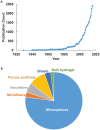Alginate microfibers as therapeutic delivery scaffolds and tissue mimics
- PMID: 36000165
- PMCID: PMC9837301
- DOI: 10.1177/15353702221112905
Alginate microfibers as therapeutic delivery scaffolds and tissue mimics
Abstract
Alginate, a naturally occurring polysaccharide, has been widely used in cell encapsulation, 3D culture, cell therapy, tissue engineering, and regenerative medicine. Alginate's frequent use comes from its biocompatibility and ability to easily form hydrogel in a variety of forms (e.g. microcapsules, microfibers, and porous scaffolds), which can provide immunoprotection for cell therapy and mimic the extracellular matrix for tissue engineering. During the past 15 years, alginate hydrogel microfibers have attracted more and more attention due to its continuous thin tubular structures (diameter or shell thickness ⩽ 200 µm), high-density cell growth, high handleability and retrievability, and scalability. This review article provides a concise overview of alginate and its resultant hydrogel microfibers for the purpose of promoting multidisciplinary, collaborative, and convergent research in the field. It starts with a historical review of alginate as biomaterials and provides basics about alginate structure, properties, and mechanisms of hydrogel formation, followed by current challenges in effective cell delivery and functional tissue engineering. In particular, this work discusses how alginate microfiber technology could provide solutions to unmet needs with a focus on the current state of the art of alginate microfiber technology and its applications in 3D cell culture, cell delivery, and tissue engineering. At last, we discuss future directions in the perspective of alginate-based advanced technology development in biology and medicine.
Keywords: 3D culture; Alginate; cell delivery; hydrogel; microfiber; stem cell; tissue engineering.
Conflict of interest statement
The author(s) declared the following potential conflicts of interest with respect to the research, authorship, and/or publication of this article: M.J. is currently the founder of a startup company, Midux Laboratories LLC. Y.X. is an advisory board member and consultant for Midux. Y.X., M.J., and S.C.R.K. have a patent application (17/153,867), titled “Devices and Methods of Producing Tubular Systems for Cell Culture.” The other authors declare no conflict of interest.
Figures






References
-
- Betz JF, Cheng Y, Tsao C-Y, Zargar A, Wu H-C, Luo X, Payne GF, Bentley WE, Rubloff GW. Optically clear alginate hydrogels for spatially controlled cell entrapment and culture at microfluidic electrode surfaces. Lab Chip 2013;13:1854–8 - PubMed
-
- Jorgensen M, Gibbons A, Sui K, Carpenter R, Zhang X, Xie Y. Predictable fabrication of pre-made alginate hydrogel microtubes for stem cell aggregation using needle-in-needle devices. Biofabrication 2021;13:035043 - PubMed
-
- Khalid GM, Selmin F. Applications of alginates in the design and preparation of orodispersible dosage forms. In: Deniz I, Imamoglu E, Keskin-Gundogdu T. (eds) Properties and applications of alginates. London: IntechOpen, 2021. DOI: 10.5772/intechopen.98610
-
- Stanford E. British Patent 142, 1881
Publication types
MeSH terms
Substances
Grants and funding
LinkOut - more resources
Full Text Sources
Miscellaneous

